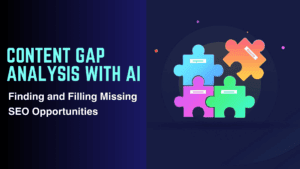Google has been progressively leveraging artificial intelligence (AI) to enhance its search engine capabilities, making search results more personalized, accurate, and user-friendly. One of the latest advancements includes AI-generated overviews in search results. These summaries offer users a concise answer to their queries, directly pulling information from the most reliable and relevant sources.
As a content creator, being featured in Google’s AI overviews can significantly increase your content’s visibility and drive substantial traffic to your website. If you’re wondering how to rank on Google’s AI overviews, this comprehensive guide will walk you through the essential steps and strategies. Let’s dive into the details.
Understanding Google’s AI Overviews
Google’s AI Overviews are designed to deliver quick, reliable answers to user questions by summarizing information from various sources. The content that appears in these overviews is selected based on its relevance, clarity, and authority. To successfully get your content featured, it’s essential to understand how Google’s algorithms evaluate and rank content.
These summaries appear at the top of the search engine results page (SERP) and are generated using machine learning algorithms. The AI pulls data from various sources to present a synthesized answer.
Key characteristics of Google’s AI overviews:
- Concise Summaries: They aim to provide short, precise answers.
- High Credibility: Only the most authoritative and trustworthy sources are referenced.
- Relevance: Content is selected based on its ability to answer specific search intent.
- Structured Data Utilization: Google prefers content that’s well-organized and utilizes structured data.

Why Ranking in Google’s AI Overviews Matters
Getting your content featured in these AI summaries offers multiple benefits:
- Increased Visibility: AI overviews are prominently displayed at the top of search results, giving your content prime real estate on SERPs.
- Boosted Traffic: Being featured can lead to a significant increase in click-through rates (CTR).
- Authority Building: Inclusion signals that Google recognizes your content as reliable and valuable.
- Enhanced Brand Recognition: Users associate featured content with expertise and trustworthiness.
To capitalize on these benefits, you need to focus on optimizing your content for Google’s AI results.
Also Learn About: Discover the Hidden Method to Turn Off Google AI Overview
Key Strategies to Rank on Google’s AI Overviews
1. Prioritize Search Intent
Google’s algorithms are becoming increasingly sophisticated in identifying and fulfilling user intent. To rank in AI overviews, you must align your content with the specific needs of your target audience.
How to identify search intent:
- Informational Intent: Users are seeking knowledge (e.g., “How does Google AI work?”).
- Navigational Intent: Users want to visit a specific site (e.g., “Google AI tools”).
- Transactional Intent: Users are looking to take action (e.g., “Best tools to optimize Google AI content”).
Tailor your content to answer these intents effectively, using clear language and addressing common questions.
2. Ensure Crawlability and Indexability
Before anything else, ensure that your website is easily crawlable and indexable by Google. If your content cannot be accessed by Google’s bots, it won’t appear in search results or AI Overviews.
- Use Google Search Console to identify and fix crawl errors.
- Submit an XML sitemap to help Google discover your pages efficiently.
3. Adhere to E-E-A-T Principles
E-E-A-T stands for Experience, Expertise, Authoritativeness, and Trustworthiness. These principles are vital for establishing the credibility of your content.
- Provide accurate and credible information.
- Highlight author credentials through bios and backlinks.
- Regularly update your content to maintain its relevance.
4. Use Structured Data Markup
Structured data helps search engines understand your content better. By implementing schema markup, you make it easier for Google’s AI to identify the most important parts of your content.
Popular schema types to consider:
- FAQ schema
- How-to schema
- Article schema
- Product schema (if applicable)
Tools like Google’s Structured Data Markup Helper can assist in implementing schema markup.
5. Create High-Quality, Comprehensive Content
Google’s AI prioritizes content that is thorough, accurate and well-researched. Thin or low-quality content has no place in AI-generated overviews.
Tips for creating authoritative content:
- Deep Research: Back your points with credible sources and data.
- In-depth Coverage: Aim to provide the most comprehensive answer to the query.
- Readability: Use simple language and break up long paragraphs to ensure easy reading.
- Multimedia: Include images, infographics, and videos to enhance content quality.
6. Optimize for Featured Snippets
AI overviews often pull information from content that’s already optimized for featured snippets. These are concise answers that Google displays in response to queries.
How to optimize for featured snippets:
- Use clear and direct headings (H2s and H3s) to structure your content.
- Create bulleted or numbered lists for step-by-step guides.
- Write concise paragraphs that directly answer questions.
7. Leverage AI Tools for Content Optimization
Utilize AI-driven SEO techniques for higher rankings. Tools like Clearscope, Surfer SEO, and MarketMuse can help you:
- Identify target keywords and related terms.
- Analyze competitor content for gaps.
- Optimize readability and structure.
AI tools can also help you ensure that your content meets the specific requirements for Google’s AI-driven rankings.

Optimizing Content for Google’s AI Results
Keyword Research and Placement
Your primary keyword, “how to rank on Google’s AI overviews,” should be strategically placed throughout your content. Secondary keywords like “optimizing content for Google’s AI results” and “Google AI search ranking strategies” should also appear naturally.
Best practices for keyword placement:
- Include primary and secondary keywords in the title, meta description, and headings.
- Use variations of the keywords to avoid over-optimization.
- Maintain a keyword density of around 1-2%.
Improve Page Load Speed
Page speed is a crucial ranking factor. Slow-loading pages are less likely to be featured in AI overviews.
Ways to improve load speed:
- Optimize images by compressing them.
- Minimize CSS and JavaScript files.
- Use a content delivery network (CDN).
- Enable browser caching.
Mobile Optimization
With the majority of searches happening on mobile devices, your website must be mobile-friendly. Google’s mobile-first indexing prioritizes content that offers a seamless mobile experience.
Mobile optimization tips:
- Use responsive design.
- Ensure buttons and links are easily clickable.
- Optimize font sizes for readability.
Build Backlinks
Backlinks from authoritative websites signal to Google that your content is trustworthy and valuable.
How to build quality backlinks:
- Publish guest posts on reputable sites.
- Collaborate with influencers in your niche.
- Create shareable content like infographics or research studies.
Tracking and Improving Performance
Once your content is optimized, monitor its performance to ensure it’s achieving desired results.
Metrics to track:
- Impressions and CTR: Analyze these using Google Search Console.
- Bounce Rate: High bounce rates indicate a mismatch with user intent.
- Rankings: Monitor how your content ranks for target keywords.
Use analytics tools like Google Analytics, Ahrefs, and SEMrush to gather insights and make data-driven improvements.
Also Read: AI Enhanced SEO Reporting: Transforming Data into Actionable Insights
Examples of High-Readability Answers
1. What is Remote Access?
Remote access allows users to connect to a computer or network from a distant location. This technology enables individuals to access files, applications, and resources as if they were physically present at the location. Common methods of remote access include:
- Virtual Private Network (VPN): Encrypts internet traffic and masks the user’s IP address.
- Remote Desktop Protocol (RDP): Allows users to control another computer remotely.
- Cloud Services: Provides access to applications and data over the internet.
This feature is widely used in businesses for telecommuting and by IT professionals for troubleshooting.
2. How to Improve SEO for Your Website?
Improving SEO involves several key strategies:
- Keyword Research: Identify relevant keywords that potential visitors are searching for.
- On-Page Optimization: Ensure that titles, headers, and content include your target keywords naturally.
- Quality Content Creation: Produce valuable content that answers user questions and engages readers.
- Link Building: Acquire backlinks from reputable sites to enhance your site’s authority.
- Mobile Optimization: Ensure your website is mobile-friendly to cater to users on various devices.
By implementing these strategies, you can enhance your website’s visibility in search results.
3. What Are the Benefits of Meditation?
Meditation offers numerous benefits for mental and physical health:
- Reduces Stress: Regular practice can lower stress levels and promote relaxation.
- Enhances Focus: Meditation improves concentration and attention span.
- Promotes Emotional Well-being: It can lead to increased self-awareness and a more positive outlook on life.
- Improves Sleep Quality: Many find that meditation helps them fall asleep faster and enjoy deeper sleep.
Incorporating meditation into your daily routine can significantly improve overall well-being.

Characteristics of High-Readability Answers
- Conciseness: Answers should be brief, typically around 150-200 words, providing essential information without unnecessary details.
- Clarity: Use simple language and avoid jargon unless necessary; when using technical terms, provide definitions.
- Structure: Utilize bullet points or numbered lists to break down complex information into digestible parts.
- Directness: Address the query directly at the beginning of the response before expanding on related points.
- Relevance: Ensure all information presented is directly related to the user’s query, enhancing the likelihood of being featured in AI Overviews.
By adhering to these principles, content creators can increase their chances of having their answers featured prominently in Google’s AI Overviews, thus improving visibility and engagement with their audience.
The Future of AI-Driven SEO
As AI continues to evolve, search engines will prioritize user-focused content that delivers value, aligns with search intent, and leverages structured data. Staying ahead requires adapting to these trends and consistently improving your content strategy.
Emerging trends to watch:
- Greater emphasis on conversational search.
- Increased reliance on multimedia content.
- Enhanced importance of E-E-A-T (Experience, Expertise, Authoritativeness, Trustworthiness).
Conclusion
Ranking in Google’s AI overviews is a game-changing opportunity for content creators and businesses. By focusing on search intent, implementing structured data, creating high-quality content, and leveraging AI tools, you can improve your chances of being featured. Remember, consistency and adaptability are key to staying ahead in the dynamic world of AI-driven SEO.
By focusing on how to rank on Google’s AI overviews through effective optimization techniques, you position yourself favorably within the evolving realm of SEO driven by artificial intelligence.


